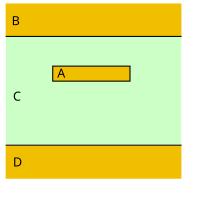Stripline

Have you ever seen a map where there are lines that show you where to go? Stripline is kind of like that, but for electricity!
Imagine you have a piece of metal, like a copper sheet. If you want to send an electrical signal through it from one place to another, you could just connect wires to the metal and have the electricity travel through those wires. But what if you don't want the wires to be visible? That's where stripline comes in.
Stripline is basically a hidden pathway for electricity within the copper sheet. Engineers carve away a section of the copper to create a narrow strip or channel, which they then fill with a special material that helps conduct electricity. This creates a hidden pathway for the electricity to travel through.
Why would you want to use stripline instead of visible wires? Sometimes you might be working with electronics that need to be very compact and space-efficient. By using stripline, you can create pathways for electricity without taking up extra room with visible wires.
So, in summary: stripline is like a hidden pathway for electricity within a metal sheet, kind of like the lines on a map that show you where to go. It's useful for when you need to send electrical signals in tight spaces without taking up extra room with visible wires.
Imagine you have a piece of metal, like a copper sheet. If you want to send an electrical signal through it from one place to another, you could just connect wires to the metal and have the electricity travel through those wires. But what if you don't want the wires to be visible? That's where stripline comes in.
Stripline is basically a hidden pathway for electricity within the copper sheet. Engineers carve away a section of the copper to create a narrow strip or channel, which they then fill with a special material that helps conduct electricity. This creates a hidden pathway for the electricity to travel through.
Why would you want to use stripline instead of visible wires? Sometimes you might be working with electronics that need to be very compact and space-efficient. By using stripline, you can create pathways for electricity without taking up extra room with visible wires.
So, in summary: stripline is like a hidden pathway for electricity within a metal sheet, kind of like the lines on a map that show you where to go. It's useful for when you need to send electrical signals in tight spaces without taking up extra room with visible wires.
Related topics others have asked about:
